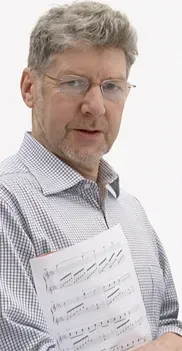John Barton's Music Logic Lessons Online
Module 2 - Lesson 11

HomeWork & Summary
LESSON ELEVEN
Space for future notes
Space for future notes
Space for future notes
Space for future notes
John Barton's Music Logic Lessons Online
Module 2 - Lesson 11
Videos and excercises below
Please do not share this Link
Video 11.1 Sharps and Flats Part 1
Sharps & Flats
Sharps and flats are great. They are relatively easy to work with and understand if presented in an orderly fashion. This is an example of how sharps and flats work on all instruments. Not just keyboards.
A good starting definition for a sharp is “ the very next note up “ and for flat “ the very next note down “. This means on a keyboard a sharp or flat will sometimes be a black note or a white note.

Figure 11-1 shows that C sharp would be a black key whereas C flat is a black key. In each case the sharp is “ the very next note up “ and the flat is “ the very next note down “.
It is very important to like the idea that sharps and flats can sometime be white keys.
On a guitar a sharp or flat is simply the very next fret up or down.
Accidentals
The word accidental is applied to various symbols that indicate a note is to be sharped or flatted or returned to its natural state.
Natural
A ‘natural’ as the name implies has the power to cancel any sharp or flat and return the note to its natural position.

Figure 11-2 demonstrates C sharp with the following C being returned to its natural state. The power of a sharp or flat lasts through a measure and this is one of the reasons that make naturals important.

Figure 11-3 shows 4 C’s in a row. The first C has no accidental in front of it so it is in a natural state. The second and third C’s are being sharped. The fourth C has been returned back to the natural state.

Figure 11-4 shows 4 ‘B’ notes ( one below C ) The first 3 notes are being flatted ( an extra ‘ flat ‘ symbol was needed as the power of the first flat only lasted for the first measure while the fourth note is natural.

Figure 11-5 shows examples of symbols for – sharp – flat – natural so that you can practice writing them. Have fun with what you have learned here.
Title goes here
Video 11.2 Sharps and Flats Part 2
Video 11.3 Naturals
Video 11.4 A Note with Two Names
Video 11.5 Drawing Accidentals
Video 11.6 Poke the Notes
Video 11.7 Happy Blues
Happy Blues is a great piece of music to demonstrate important music concepts. If you like the sound of it and like to perform it, then that will be a bonus.
We are going to look at two measures – measures 13 & 14 on page 19 of Music Logic Book Two. Also we are going to look at these measures in three installments;
First – basic notes.
Second – are there any accidentals? and
Third – what is the suggested fingering?

Figure 11-6 shows the basic notes. Altogether there are eight notes (the two notes joined by a ‘tie ‘ should be counted as one note).
If I asked you to show me these notes on a keyboard you would probably respond, “ sure, the first note is C then the following notes move by – up one – up one – the same – up a jump – up one – up a jump – the same “. Great

Figure 11-7 shows we now have two accidentals. The third note is flatted ( very next note down – black key ) and the fourth note is returned to its natural state.

Figure 11-8 is all about sensible fingers. In this example the fingering has been indicated as professional notation (i.e. not all the notes have finger indications )
four notes have finger suggestions – four notes with no finger suggestions the reasoning is that the fingering for the unmarked notes will occur naturally.
WHY FANCY FINGERING ?
If the notes are to be played quickly in succession (fast tempo) then care must be taken to choose the most practical set of fingering. Different musicians will use different fingers while playing the same piece of music.
We will be in touch for the next lesson
keep an eye on your email
John Barton
Music Logic